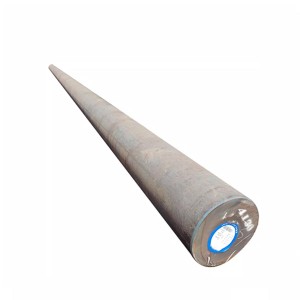In order to better understand the advantages of stainless steel pipes, let us first understand the raw material of stainless steel pipes: stainless steel. Stainless steel refers to steel that is resistant to weak corrosive media such as air, steam, and water, and chemically corrosive media such as acid, alkali, and salt, and is also called stainless acid-resistant steel. In practical applications, steel that is resistant to corrosion by weak corrosive media is often called stainless steel, and steel that is resistant to chemical media is called acid-resistant steel. Due to the difference in chemical composition between the two, the former is not necessarily resistant to corrosion by chemical media, while the latter is generally non-corrosive. The corrosion resistance of stainless steel depends on the alloying elements contained in the steel.
Usually, according to the metallographic structure, ordinary stainless steel is divided into three categories: austenitic stainless steel, ferritic stainless steel, and martensitic stainless steel. Based on these three basic metallographic structures, for specific needs and purposes, dual-phase steels, precipitation hardening stainless steels, and high-alloy steels with iron content less than 50% have been derived.
According to metallographic organization:
01 Austenitic stainless steel.
The matrix is mainly stainless steel with face-centered cubic crystal structure (CY phase) austenite, non-magnetic, and mainly strengthened by cold working (and may lead to certain magnetic properties). The American Iron and Steel Institute uses numbers in the 200 and 300 series, such as 304.
02 Ferritic stainless steel.
The matrix is mainly a ferrite structure with body-centered cubic crystal structure ((a-phase), which is magnetic and generally cannot be hardened by heat treatment, but can be slightly strengthened by cold working. The American Iron and Steel Institute uses 430 and 446 as labels.
03 martensitic stainless steel.
The matrix is a stainless steel with martensite structure (body-centered cubic or cubic), magnetic, and its mechanical properties can be adjusted by heat treatment. The American Iron and Steel Institute is marked with 410, 420 and 440 numbers. Martensite has an austenite structure at high temperatures, and when cooled to room temperature at an appropriate speed, the austenite structure can be transformed into martensite (ie, hardened).
04 Austenitic-ferritic (duplex) stainless steel.
The matrix has a two-phase structure of austenite and ferrite. The content of the lesser phase matrix is generally greater than 15%. It is magnetic and can be strengthened by cold working. 329 is a typical duplex stainless steel. Compared with austenitic stainless steel, dual-phase steel has higher strength, and has significantly improved resistance to intergranular corrosion, chloride stress corrosion and pitting corrosion.
05 precipitation hardening stainless steel.
A stainless steel whose matrix is austenite or martensite and can be hardened by precipitation hardening treatment. The American Iron and Steel Institute uses the 600 series of numbers, such as 630, or 17-4PH.
Generally speaking, in addition to alloys, the corrosion resistance of austenitic stainless steel is relatively excellent. In a low corrosive environment, ferritic stainless steel can be used. In a mildly corrosive environment, if the material is required to have high For strength or high hardness, martensitic stainless steel and precipitation hardening stainless steel can be used.
There are three main factors affecting the corrosion of stainless steel pipes:
1. The content of alloying elements.
Generally speaking, the chromium content of 10.5% steel is not easy to rust. The higher the content of chromium and nickel, the better the corrosion resistance. For example, the content of nickel in 304 material is 8-10%, and the content of chromium reaches 18-20%. Such stainless steel pipes will not rust under normal circumstances.
2. The smelting process of the manufacturer will also affect the corrosion resistance of stainless steel and thus the corrosion resistance of stainless steel pipes.
A large stainless steel plant with good smelting technology, advanced equipment and advanced technology can guarantee the control of alloying elements, the removal of impurities, and the control of the cooling temperature of the billet, so the product quality is stable and reliable, the internal quality is good, and it is not easy to rust. On the contrary, some small steel mills have backward equipment and technology. During the smelting process, impurities cannot be removed, and the products produced will inevitably rust.
3. External environment, dry and ventilated environment is not easy to rust.
And the air humidity is high, continuous rainy weather, or the environment with high pH in the air is easy to rust. 304 stainless steel pipe, if the surrounding environment is too bad, it will rust.
How to deal with rust spots on stainless steel pipes?
1. Chemical methods
Use pickling paste or spray to assist the re-passivation of the rusted parts to form a chromium oxide film to restore corrosion resistance. After pickling, in order to remove all contaminants and acid residues, it is very important to rinse with clean water. After all treatments, use polishing equipment to polish again, and then seal with polishing wax. For those with slight rust spots, you can also use a 1:1 gasoline and engine oil mixture to wipe off the rust spots with a clean cloth.
2. Mechanical method
Sandblasting, using glass or ceramic particles to clean, submerge, brush and polish. It is possible to use mechanical methods to wipe off the pollution caused by the previously removed materials, polishing materials or oblique materials. All kinds of pollution, especially foreign iron particles, can become a source of corrosion, especially in humid environments. Therefore, mechanically cleaned surfaces should be properly cleaned under dry conditions. The use of mechanical methods can only clean the surface, and cannot change the corrosion resistance of the material itself. Therefore, it is recommended to re-polishing with polishing equipment after mechanical cleaning and sealing with polishing wax.
Commonly used stainless steel pipe grades and performance:
1. 304 stainless steel pipe is one of the most widely used austenitic stainless steels, which is suitable for mechanical structures and acid pipelines.
2. 304L stainless steel tube is an ultra-low carbon austenitic stainless steel tube developed to solve the serious intergranular corrosion tendency of 304 stainless steel tube under certain conditions due to the precipitation of Cr23C6. Its sensitized state is significantly better than intergranular corrosion resistance. 304 stainless steel pipe. Except for the slightly lower strength, the other properties are the same as 321 stainless steel pipe. It is mainly used for corrosion-resistant equipment and parts that cannot be solid-solution treated after welding, and can be used for mechanical structures.
3. 304H stainless steel pipe. The internal branch of 304H stainless steel pipe has a carbon mass fraction of 0.04%-0.10%, and its high temperature performance is better than that of 304 stainless steel pipe.
4. 316L stainless steel pipe. Ultra-low carbon steel has good resistance to intergranular corrosion in the sensitized state and is suitable for the petrochemical industry.
5. 316H stainless steel pipe. The internal branch of 316 stainless steel pipe has a carbon mass fraction of 0.04%-0.10%, and its high temperature performance is better than that of 316 stainless steel pipe.
6. 321 stainless steel pipe. Titanium-stabilized austenitic stainless steel tube, adding titanium to improve intergranular corrosion resistance, and has good high-temperature mechanical properties, which can be replaced by ultra-low carbon austenitic stainless steel tube. Recommended for special occasions such as high temperature or hydrogen corrosion resistance.
7. 347 stainless steel pipe. Niobium-stabilized austenitic stainless steel tube, adding niobium to improve intergranular corrosion resistance, corrosion resistance in acid, alkali, salt and other corrosive media is the same as 321 stainless steel tube, good welding performance, good corrosion resistance and high temperature resistance, suitable for For heat exchanger tubes, furnace tubes, etc.
8. 904L stainless steel pipe. Super completely austenitic stainless steel pipe is a super austenitic stainless steel pipe invented by Finland Outokumpu (OUTOKUMPU). Its nickel mass fraction is 24% to 26%, carbon mass fraction is less than 0.02%, and it has corrosion resistance. Excellent. It has good corrosion resistance in non-oxidizing acids such as sulfuric acid, acetic acid, formic acid, and phosphoric acid, as well as good crevice corrosion and stress corrosion resistance. It is suitable for sulfuric acid of various concentrations below 70°C, and has good corrosion resistance in acetic acid at any concentration and at any temperature and mixed acid of formic acid and acetic acid under normal pressure. The case of Rolex watches is also made of 904L stainless steel.
9, 300 series-chromium-nickel austenitic stainless steel pipe
301—Good ductility, used for molded products. It can also be quickly hardened by mechanical processing and has good weldability. Abrasion resistance and fatigue strength are better than 304 stainless steel. 301 stainless steel exhibits obvious work hardening during deformation, and is used in various occasions requiring higher strength
302—In essence, it is a variant of 304 stainless steel with higher carbon content, which can be made to obtain higher strength through cold rolling.
302B—is a kind of stainless steel with high silicon content, which has high resistance to high temperature oxidation.
303 and 303Se are free-cutting stainless steels containing sulfur and selenium respectively, which are used in occasions where free cutting and high surface gloss are required. 303Se stainless steel is also used to make parts that require hot upsetting, because under such conditions, this stainless steel has good hot workability.
304N—is a nitrogen-containing stainless steel. Nitrogen is added to increase the strength of the steel.
305 and 384—Stainless steel contains high nickel, and its work hardening rate is low. It is suitable for various occasions that require high cold formability.
308—Used to make electrodes.
309, 310, 314 and 330 stainless steels have relatively high nickel and chromium content in order to improve the oxidation resistance and creep strength of the steel at high temperatures. While 30S5 and 310S are variants of 309 and 310 stainless steels, the difference is that the carbon content is lower in order to minimize the carbides precipitated near the weld. 330 stainless steel has a particularly high resistance to carburization and thermal shock resistance.
Classification of stainless steel pipe, a comprehensive understanding of 300 series stainless steel Related Video:
owing to excellent assistance, a variety of high quality products and solutions, aggressive costs and efficient delivery, we take pleasure in an excellent popularity amongst our customers. We are an energetic business with wide market for , , , Our company always concentrate on the development of the international market. We now have a lot of customers in Russia , European countries, the USA, the Middle East countries and Africa countries. We always follow that quality is foundation while service is guarantee to meet all customers.

